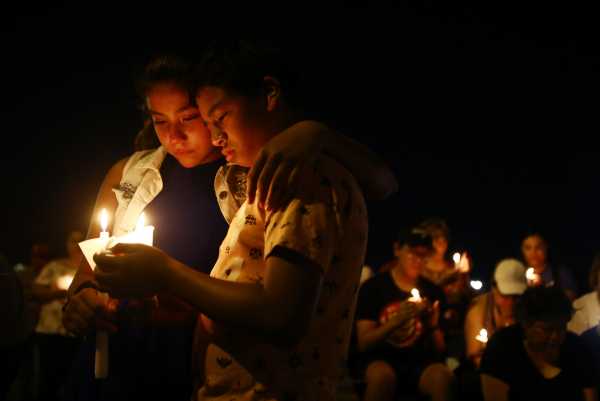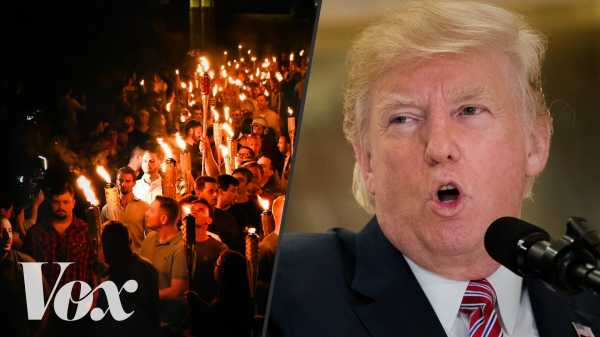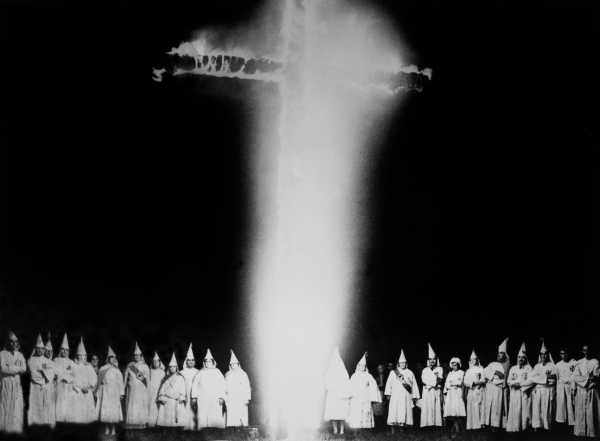
The El Paso shooter is not a fluke or an anomaly. He is part of a resurgence of white nationalist violence in the United States, a wave of killings that are themselves part of a very long history of political violence by American racists and white nationalists.
In the years after the Civil War, the Ku Klux Klan and other terrorist groups launched a wave of killings aimed at intimidating newly freed black people and restoring the antebellum racial order. Around the same time, an increase in immigration from East Asia and Mexico in the late 19th and early 20th centuries led to a wave of lynchings and mob violence targeting migrants, including large-scale race riots in Los Angeles in 1871 and in El Paso in 1916.
At various points in the 20th century, white supremacists reacted viciously against continued immigration from ethnic and religious minorities and tried to suppress movements for black civil rights by force. In 1963 alone, they assassinated NAACP field secretary Medgar Evers and killed four black girls in a bombing attack on the 16th Street Baptist Church in Montgomery, Alabama.
The 2015 attack on a black church in Charleston, South Carolina; the 2017 fatal car attack in Charlottesville, Virginia; the 2018 shooting at a synagogue in Pittsburgh; this weekend’s shooting in El Paso — these are not isolated incidents, but evidence that we are once again in the midst of a wave of white racial violence.
According to data from the Anti-Defamation League (ADL), a Jewish anti-hate group, right-wing extremists were responsible for every documented killing by a political extremist in the United States in 2018. In late July testimony before the US Senate, FBI Director Christopher Wray reported that the FBI had already made as many domestic terrorism arrests in 2019 as it did in all of 2018 — and, further, that “a majority of the domestic terrorism cases that we’ve investigated are motivated by some version of what you might call white supremacist violence.”
So why is this happening now, and what are the racist killers trying to accomplish?
The answers to these questions are complicated. But at the center of the story is, as it was historically, a sense among white racists that white control over America is slipping.
Rising diversity and the victories of the civil rights movement threatened white dominance, much as white control was threatened by Reconstruction and mass immigration in the past. Faced with these perceived threats, white supremacists have used violence strategically throughout American history to fend off this demographic shift — or, in the words of the El Paso shooter and President Trump, an “invasion” by nonwhites. Today, their goal is to sow terror in nonwhite communities and radicalize whites, and to lay the groundwork for a return to a more explicitly racist political regime in the United States.
So while the current wave of white nationalist violence is new, it is at root part of something very old. And any serious assessment of this history reveals something frightening: that the good guys don’t always win.
Especially when the militants have fellow travelers in positions of power.
Why white supremacist violence is on the rise today
There are a dizzying number of racist hate groups in the United States, many of which have been around for decades, or, in the case of the KKK, more than a century. The Southern Poverty Law Center (SPLC) counts hundreds of such groups, separated into distinct categories like “white nationalist,” “neo-Confederate,” “neo-Nazi,” and “racist skinhead.”
These groups differ on many points, including the justifiability of violence. But one thing they share is a sense of impending demographic doom: the notion that the United States is a white nation being swamped by mass nonwhite immigration (often described as being orchestrated by a Jewish conspiracy) and higher birthrates among native-born nonwhites. The browning of America — a real phenomenon — has produced a sense of displacement among a nontrivial number of white natives, manifesting in far-right claims about a “white genocide” taking place in America.
“The idea of that threat has been central to white power activism for decades,” Kathleen Belew, a historian of American racist movements at the University of Chicago, writes in the New York Times. “To people in this movement, the impending demographic change understood by many commentators as a soft transformation — the moment when a town, a county, or a nation will no longer be majority-white — isn’t soft at all, but rather represents an apocalyptic threat.”
Historically, power transitions between ethnic groups have led to violence. In his 2002 book Understanding Ethnic Violence, MIT political scientist Roger Petersen argued that ethnic killing is often caused by a particular kind of collective resentment: the feeling of injustice on the part of a privileged portion of society when it sees power slipping into the hands of a group that hadn’t previously held it.
Drawing on social psychology, Petersen argued that one of the underappreciated causes of ethnic violence was a change in the legal and political status of majority and minority ethnic groups. Members of dominant groups simply believe they deserve to be the dominant force in their societies, and resent those challenging their positions at the top of the pyramid.
A 2010 paper published in the journal World Politics tested Petersen’s theory, looking at 157 cases of ethnic violence in nations ranging from Chad to Lebanon. It found strong statistical correlations between a group’s decline in status and the likelihood that it turns to violence against another group.
Petersen’s research suggests that in advanced democracies, much of this anger will be channeled through the political system rather than mass violence. Hence the rise of Donald Trump, whose voters (particularly in the Republican primary) were disproportionately defined by high levels of racial grievance.
But the mainstream can’t be separated from the extreme quite so cleanly. Indeed, experts think Trump’s rise to power played a crucial role in inspiring the current wave of white nationalist violence — in helping turn inchoate anxiety about demographic change into real, deadly action.
In particular, Trump galvanized the alt-right, the now-infamous group of online racists who were relatively obscure prior to 2015. They stepped up their activity online, with alt-right harassment and trolling becoming ubiquitous on social media in particular.

“They perceived him as anti-immigrant, anti-Muslim, and certainly anti-establishment,” says Mark Pitcavage, an expert on far-right extremism at the ADL. “They liked him quite a bit. So they really came out in force for him.”
This isn’t just Pitcavage’s opinion. One study of 75 far-right radicals found that many of them “credit his candidacy as the start of their awakening.” In his book The Alt-Right: What Everyone Needs to Know, University of Alabama professor George Hawley writes that “Trump’s presidential campaign energized the alt-right and helped the movement reach a new audience,” adding that “had Trump never entered the GOP presidential primaries … the alt-right would not have shown much interest in the 2016 presidential election.”
Press coverage of the rising alt-right presence online helped them get noticed by a wider audience. They also benefited greatly from support on two online troll havens, 4chan and 8chan. These sites, collectively referred to as “the chans,” are defined by racist memeing that’s supposedly ironic but functionally indistinguishable from genuine racism. They’ve evolved into a hub for alt-right fans, used to coordinate trolling campaigns. The more radical 8chan, whose users have been known to praise mass killers, is where the New Zealand mosque shooter, the Poway synagogue attacker, and El Paso shooter all posted their manifestos.
These factors — Trump’s rise, growing media coverage of the alt-right, and the use of the chans as organizing hubs — helped white nationalist ideas spread rapidly online. The more people who are exposed to radical ideas about white America’s demographic doom, the more likely these ideas are to reach a young white man who takes them as justification for violence — especially when there are places on the internet like 8chan openly celebrating it.
“We are in a surge of white supremacy right now,” says Pitcavage. “Whenever you have white supremacists increasing in anger and increasing in numbers, you’re going to see the violence increasing too.”
This turn toward violence has a self-sustaining element as well. Successful attacks tend to inspire copycats — the New Zealand mosque shooter, for example, was cited as an example by both the Poway synagogue shooter and the El Paso attacker. Knowing that there are forums where shooters will be celebrated, like 8chan, gives them a sense that they’ll win a kind of celebrity status — that they’ll be able to live on via online infamy even after death or arrest.
So the story of this current rise in white nationalist killing is a complex one, with everything from the media to chan culture playing a role. But at its most fundamental, it is an expression of the same white fears that gave us the Trump presidency.
A history of violence
Sometimes a white supremacist killing a nonwhite person is just a pure expression of hate. The killer simply wants to kill a black person, a Mexican American, a Jew, or a member of any other group they despise — no deeper logic than that.
But the El Paso shooting is not like this, at least based on what we know. Nor were the other high-profile instances of mass white supremacist violence in America like Pittsburgh or Charleston. Reading these killers’ manifestos suggests a much more strategic motivation — something that’s in keeping with America’s tradition of homegrown racist violence.
The KKK has died and been reborn at several points in American history. But its most infamous incarnation was immediately after the Civil War, when it functioned essentially as an armed insurgency against the Reconstruction-era government. The Klan targeted black communities and prominent Republicans deliberately, an effort to make the South literally ungovernable by Northern-aligned and pro-black forces.
“Freedmen in various counties were whipped for casting Republican ballots; others were flogged until they swore to vote the Democratic ticket or to stay home,” Michael Newton writes in The Ku Klux Klan in Mississippi: A History. “Universal suffrage was a ‘Black Peril’ which Klansmen vowed to resist at all costs.”
The logic here wasn’t violence for violence’s sake. It was to use the fear of physical harm to keep black people and sympathetic white people out of politics, allowing the racist-aligned Democratic Party to upend the results of the Civil War at the ballot box. It is violence that sows terror to accomplish specific and concrete political objectives that perpetuate white dominance — terrorism in a textbook sense. And it worked: The collapse of Reconstruction, brought on in part by Southern terrorism, allowed white supremacy to reassert itself in the form of Jim Crow.
The anti-Chinese riots of the late 19th century, though less well-known to most Americans, had a similar intent. Nativist attackers attempted to evict Chinese migrants from their towns, burning their houses and sometimes driving them out on deadly forced marches. But they also had a broader political intent — to convince Washington to change the law to dramatically restrict the number of immigrants allowed into the country. Princeton historian Beth Lew-Williams explains the basic logic in her book The Chinese Must Go:
The anti-Chinese “vigilantes,” as Lew-Williamson terms them, were as successful as the Klan was. Prior to the waves of anti-Chinese violence, “national exclusion was a particularly radical objective,” she writes. Subsequent federal restrictions on Chinese immigration were partly designed “to combat the more immediate threat of immediate white violence” — ending terrorism by giving the terrorists what they want.
Many of today’s white nationalist killers share similar objectives. While their targets may seem random and unpredictable, they share a hope of actually making a broader kind of political change. The constant drumbeat of attacks is aimed at terrorizing minorities and further energizing racist whites, to return American politics to a time when it was (even more) acceptable to advocate openly racist ideas and policies.

The Charleston shooter launched one of the earlier attacks in the recent wave — taking place a day after Trump announced his presidential run. He opened fire in a black church in the hopes of reaching white audiences, to wake them up to the threat to America posed by large nonwhite minorities. His goal was to start a political movement, to foment (as he allegedly told arresting officers after the shooting) a race war in the United States.
“I would rather live imprisoned knowing I took action for my race than to live with the torture of sitting idle,” he wrote in a jailhouse journal. “I did what I thought would make the biggest wave. And now the future of our race sits in the hands of my brothers who continue to live freely.”
The Pittsburgh shooter was more focused, singling out HIAS — a Jewish group that focuses on refugee resettlement — as a specific threat to white America. He attacked a synagogue with the explicit aim of stopping Jews from engaging in this kind of pro-migrant activism.
“HIAS likes to bring invaders in that kill our people. I can’t sit by and watch my people get slaughtered,” he wrote on Gab, a social media site popular with the alt-right. “Screw your optics. I’m going in.”
The El Paso shooter wrote in his manifesto that he hopes his act of violence can scare off Hispanic migrants, convincing those who have come to the United States to leave.
“I am simply defending my country from cultural and ethnic replacement brought on by an invasion,” he wrote. “The Hispanic population is willing to return to their home countries if given the right incentive. An incentive that myself and many other patriotic Americans will provide.”
Looking at the attacks as discrete events is a mistake, one akin to treating every lynching or anti-Chinese riot as a separate and disconnected incident. The overarching goal, the thing these attacks have in common and that connects them to a legacy of racial violence in America, is the aim of creating a climate of fear and anger — one in which minority groups are scared and more whites are won over to the racist cause. Ultimately, over time, this could help them change America along the lines of what they want.
It is very hard to imagine that El Paso is the last we’ve seen of this kind of violence.
And the Trump presidency, unfortunately, is making things worse. The president’s policy inaction on white supremacy, combined with his willingness to outright parrot white supremacist language, further emboldens white nationalists. This isn’t mere speculation, but rather what they say on their websites.
“It is too simplistic to blame President Trump and his inflammatory rhetoric for the rise of white-supremacist violence. But that doesn’t mean his language isn’t a contributing factor,” Juliette Kayyem, a former assistant secretary of homeland security, writes in the Washington Post. “He fails to shame them. His rhetoric winks and nods, curries favor, embraces both sides and, while not promoting violence specifically, certainly does not condemn it (until after it occurs).”
Irresponsible is too kind a word for this behavior. If history has taught us anything, it’s this: White violence can exert tremendous influence on American politics and society. We underestimate its rise at our peril.
Sourse: vox.com






